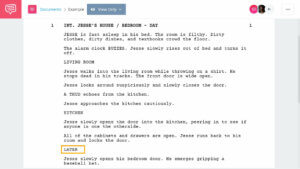


Screenwriting software takes a lot of the heavy lifting away, but a writer must know the industry standards, regardless. Your script represents a blueprint for the director and production crew.įormatting isn’t sexy, but it’s a requirement of screenwriting.

When you’re writing the first draft, don’t put limitations on yourself, but when you rewrite, examine the number of locations and slice and dice, where possible. Screenwriting software remembers each slugline and allows you to insert it wherever needed, which also allows a director to keep track of locations to create a shooting schedule. Some locations are inexpensive, but others are simply impossible, unless the production company can recreate it on a set or use a greenscreen.įilms are never shot in order of scene, but instead, shot by locations, using sluglines to guide them. Increased costs occur every time a camera and crew must move to a new location. As the number of locations increases, so does the film’s price tag. Whenever writers identify a specific time of day, the director has limitations on when he can shoot those scenes. For example, each scene being shot in the daylight or darkness, during sunrise or sunset, represents not only cost, but also time constraints during production. Locations also aid the producer in identifying the script’s budget. Inside or outside, day or night, or what room in what building. Simply put, a slugline (or slug line) is a scene heading to help orient the reader quickly as to where that action takes place. The greatest compliment a writer can get is when an executive calls their script “a fast read.” Making your script read quickly requires appropriate use of sluglines.


 0 kommentar(er)
0 kommentar(er)
